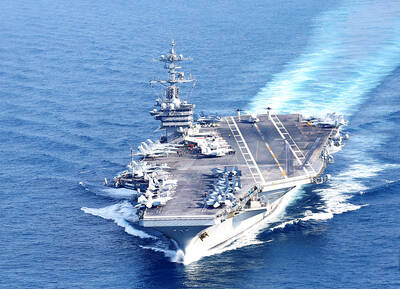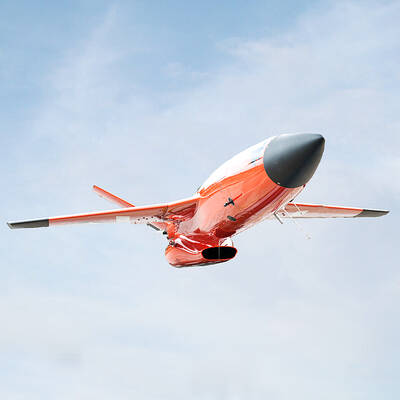US intelligence agencies have leaked reports of secret new Chinese missile tests that could have important implications for Taiwan.
The reports have been published by national security journalist Bill Gertz on the Washington Free Beacon Web site.
Gertz said US intelligence agencies had monitored a fourth flight test last week of the Dong Feng-31A (DF-31A) intercontinental ballistic missile (ICBM).
It was fired from China’s Wuzhai Space and Missile Test Center in Shanxi Province to an impact range in western China.
“Thursday’s DF-31A test came ten days after the flight test at Wuzhai of a silo-based CSS-4 Mod 2 long-range missile, and several weeks after flight tests of a new road-mobile DF-41 ICBM, on July 24, and a submarine-launched JL-2 missile on August 16,” Gertz wrote.
“China’s secretive military made no mention of any of the tests,” he said.
According to Gertz, US intelligence officials believe the DF-41 will eventually be outfitted with between three and 10 warheads.
“China is currently in the middle of a major strategic nuclear forces buildup that includes four new ICBMs — the DF-41, JL-2 [Julang-2], DF-31A, and another road-mobile missile called the DF-31,” Gertz wrote.
Richard Fisher, a specialist on China’s military with the International Assessment and Strategy Center, told the Taipei Times that the testing represents a new level of capability for China’s nuclear forces.
“It may mark the beginning of a new era in which China fields multiple ICBM types armed with multiple warheads,” Fisher said.
“Uncertainties concerning China’s nuclear missile developments are of direct importance to Taiwan,” he said.
“Any potential for China to undermine regional or Taiwanese confidence in the extended American nuclear deterrent has profound and potentially dire implications,” he said.
“For the PLA [People’s Liberation Army], nuclear checkmate of US forces would be a key part of any campaign against Taiwan,” he said.
Fisher said that were Japan to lose confidence in the extended US nuclear deterrent, it is quite well-positioned to develop both the nuclear warheads and long-range missiles to provide for its own deterrent.
Japan’s M-V solid fuel space launch vehicle was developed in part to provide the option to field a long-range ballistic missile if needed.
“Such a move by Japan could lead to similar reactions by South Korea, Vietnam, Australia and even Taiwan, which apparently ended its own nuclear weapon program in the 1980s following intervention by the [then US president Ronald] Reagan administration,” Fisher said.
“However, I am told that many of the engineers involved in this effort still reside in Taiwan,” he said.
According to Fisher, China shows “little inclination” to stop its nuclear and advanced conventional missile buildup that is undermining the US deterrent and shows “little to no interest” in the kind of transparency that might lower anxieties.
“China regularly signals that it wants American military power to depart from Asia and apparently is ready to plunge the region into a period of instability, even conflict, to emerge as its primary power,” Fisher said.
Word of the missile testing came as US Secretary of State Hillary Rodham Clinton was visiting Beijing for high-level talks with Chinese leaders.

CROSS-STRAIT COLLABORATION: The new KMT chairwoman expressed interest in meeting the Chinese president from the start, but she’ll have to pay to get in Beijing allegedly agreed to let Chinese Nationalist Party (KMT) Chairwoman Cheng Li-wun (鄭麗文) meet with Chinese President Xi Jinping (習近平) around the Lunar New Year holiday next year on three conditions, including that the KMT block Taiwan’s arms purchases, a source said yesterday. Cheng has expressed interest in meeting Xi since she won the KMT’s chairmanship election in October. A source, speaking on condition of anonymity, said a consensus on a meeting was allegedly reached after two KMT vice chairmen visited China’s Taiwan Affairs Office Director Song Tao (宋濤) in China last month. Beijing allegedly gave the KMT three conditions it had to

STAYING ALERT: China this week deployed its largest maritime show of force to date in the region, prompting concern in Taipei and Tokyo, which Beijing has brushed off Deterring conflict over Taiwan is a priority, the White House said in its National Security Strategy published yesterday, which also called on Japan and South Korea to increase their defense spending to help protect the first island chain. Taiwan is strategically positioned between Northeast and Southeast Asia, and provides direct access to the second island chain, with one-third of global shipping passing through the South China Sea, the report said. Given the implications for the US economy, along with Taiwan’s dominance in semiconductors, “deterring a conflict over Taiwan, ideally by preserving military overmatch, is a priority,” it said. However, the strategy also reiterated

‘BALANCE OF POWER’: Hegseth said that the US did not want to ‘strangle’ China, but to ensure that none of Washington’s allies would be vulnerable to military aggression Washington has no intention of changing the “status quo” in the Taiwan Strait, US Secretary of Defense Pete Hegseth said on Saturday, adding that one of the US military’s main priorities is to deter China “through strength, not through confrontation.” Speaking at the annual Reagan National Defense Forum in Simi Valley, California, Hegseth outlined the US Department of Defense’s priorities under US President Donald Trump. “First, defending the US homeland and our hemisphere. Second, deterring China through strength, not confrontation. Third, increased burden sharing for us, allies and partners. And fourth, supercharging the US defense industrial base,” he said. US-China relations under

The Chien Feng IV (勁蜂, Mighty Hornet) loitering munition is on track to enter flight tests next month in connection with potential adoption by Taiwanese and US armed forces, a government source said yesterday. The kamikaze drone, which boasts a range of 1,000km, debuted at the Taipei Aerospace and Defense Technology Exhibition in September, the official said on condition of anonymity. The Chungshan Institute of Science and Technology and US-based Kratos Defense jointly developed the platform by leveraging the engine and airframe of the latter’s MQM-178 Firejet target drone, they said. The uncrewed aerial vehicle is designed to utilize an artificial intelligence computer